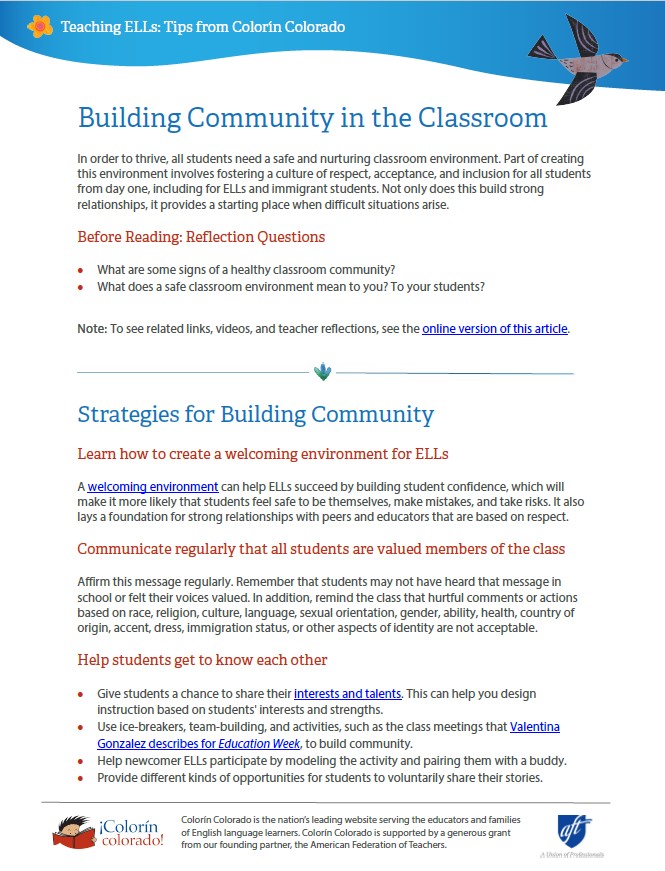Discussing Political Violence with ELLs, Immigrants, and Refugees

If topics related to political violence or unrest come up in your classroom, there are some things you can do to navigate the conversation with sensitivity and care, especially if you teach ELLs. Learn more from these tips below. This article is part of Navigating Tough Topics in the Classroom: Tips for ELL Educators.
Acknowledgements
 This project was made possible with support from the American Federation of Teachers.
This project was made possible with support from the American Federation of Teachers.
If you are discussing political violence or unrest with ELLs and immigrant students, it is essential to proceed with care and sensitivity so that students feel safe and supported within the classroom. Here are some tips to help navigate these discussions.
 Before Reading: Reflection Questions
Before Reading: Reflection Questions
- Are you aware of any of your students who have been impacted by political violence?
- Have you heard of any instances of students being bullied in relation to a political conflict?
Tips for Educators
Keep in mind that political violence may be a source of trauma for students.
Political violence and unrest may be particularly traumatic for students who have endured armed conflict, civil war, unrest, and violence in their home country.
For example:
- If you are discussing events related to a situation that impacted your students, this may be a source of trauma for them. If possible, check in with students before these discussions to see if they wish to participate, and if not, consider postponing the discussion or providing your student with other options. In addition, never put students on the spot to speak about their own perspective or as a "representative" of a particular country, race, or other identifying characteristic.
- If you are discussing global events that don't seem to have direct ties to your students, keep in mind that those ties may in fact exist, or there may be parallels to students' experiences. Follow the guidelines above.
- If you are discussing political violence and unrest happening in the United States, keep in mind that uncertainty and unrest can provoke trauma for immigrant and refugee families, particularly those who came to America due to political violence in other regions of the world.
You can support students through the following ways:
- Consider providing students with a private space to share their thoughts, such as a digital journal.
- Prepare for these discussions in collaboration with counselors and other mental health professionals.
- Connect students and families with mental health professionals (and culturally responsive mental health support) if needed.
- Learn more about trauma-informed instruction for immigrant students.
See more in the following:
Give students and families a chance to ask questions.
Students may have many opinions and questions about current events. Students may also have personal questions and considerations about their own safety or that of their families for a variety of reasons. You can support students in the following ways:
- Speak with students and families directly to find out their concerns.
- Acknowledge the difficulty that uncertainty brings.
- Find out which local organizations have ties to your community and can offer support.
- Look for ways to provide ongoing updates of information in families' home languages. Building school-community partnerships has proven to be critical in addressing families' questions and concerns about the pandemic, immigration issues, and other key topics.
- Don't lose sight of the strengths that ELL/immigrant students and families bring to their schools and our communities every day. The better you know your families, the more deeply you can tap into those strengths.
Give students need time, space, and privacy to process what is unfolding.
- Remember that some students may not wish to discuss these events right away. Finding positive things to focus on and letting students know that you are there to listen when they are ready is an important first step.
- Look for ways to embed social-emotional support and learning across the curriculum. While some students may wish to engage in group discussion, others may feel uncomfortable drawing any attention to themselves or their family's situation.
- Consider reaching out to administrators and mental health colleagues or partners to establish some more robust support for students who are under tremendous strain and perhaps feeling high levels of anxiety.
- Avoid making assumptions about any student's experience or political leanings.
Remind ELL/immigrant students and their families that they are valued members of your class, school, and community.
- Continue efforts to make them feel welcome.
- Share those ideas with colleagues and administrators as you hear them. Encourage the whole school community to look for ways to welcome all families.
Prevent bullying or harassment of ELLs and immigrant students related to current events.
- Communicate to your class that all students are valued members of the classroom and bullying or disrespectful speech, including against ELLs and immigrant students, will not be tolerated.
- Share the importance of these messages with other colleagues.
- Keep in mind that students may have already experienced bullying or harassment due to a number of factors, including their ethnicity, language, or religion.
- See helpful ideas in 8 Tips to Protect ELLs from Bullying in Your Classroom and School.
Related Resources
See more in the following resources:
- Talking About Tough Topics
- Embedding Social-Emotional Learning for ELLs Across the Curriculum in Any Learning Environment
- Social and Emotional Support for ELLs and Immigrant Students

